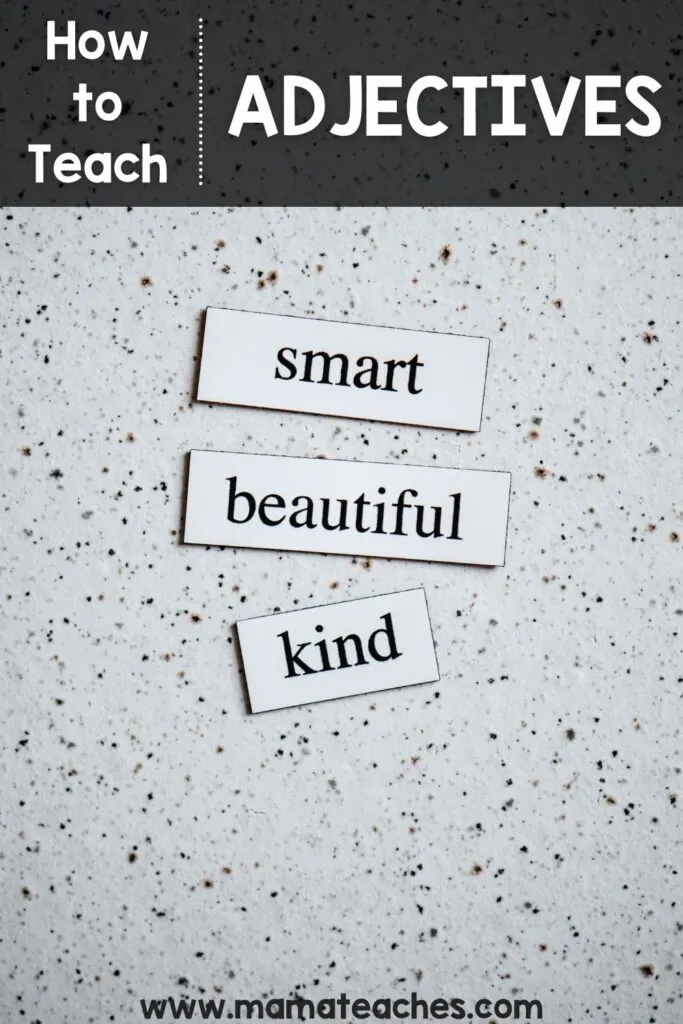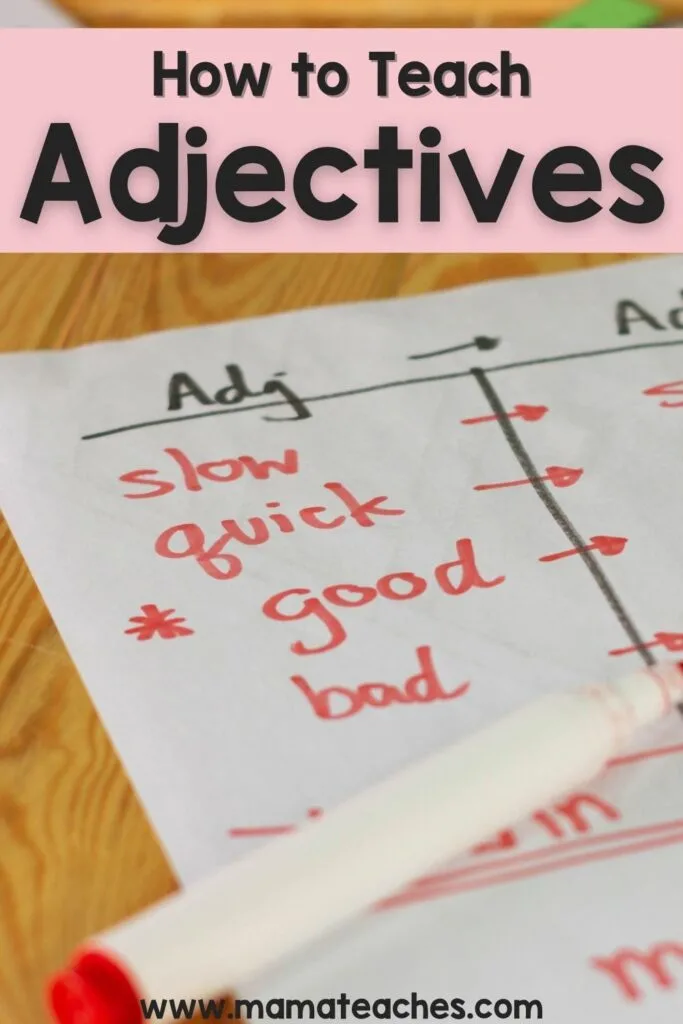Slippery, slimy, scrumptious, sugary…adjectives are delightful!
Learn how to teach adjectives and apply that knowledge to grammar and writing.
Teaching Adjectives
Our entire language is made up of only eight parts of speech, so each one is critical.
Adjectives are magical in that they transform ordinary nouns and pronouns into vivid mental pictures.
We’ll tell you all you need to know about how to teach adjectives to your students.

This article contains affiliate links to things that you might like.
What Are Adjectives?
Adjectives are words that modify nouns or pronouns.
They can do these three ways: by describing the noun/pronoun (the delectable chocolate), quantifying it (three chocolates or some chocolates), or limiting it (that chocolate).
You can identify an adjective by thinking about the question it answers.
An adjective answers one of these questions:
- What kind?
- How many?
- How much?
- Which?
- Whose?

Types of Adjectives
Language is complicated, and as you can imagine, you can deep dive into the nitty-gritty of adjectives.
Elementary (and even middle school) students don’t need the fine points of linguistics, but they do need to know the basic types of adjectives.
Keep in mind that children do not have the vocabulary of adults.
They will benefit from having a running adjective list to provide choices and examples.
Adjectives of Quality
These are the adjectives that answer the question, “What kind?” They are the easiest adjectives to identify because they are the ones connected to our senses.
For example, What kind of marshmallow?
A toasted, gooey, sugary marshmallow.
These three adjectives are adjectives of quality.
Adjectives of Number
Adjectives of number answer the question, “How many?” These could be a specific number, as in, “I ate twelve marshmallows,” or an indefinite number, “I ate some marshmallows.”

Adjectives of Quantity
Adjectives of quantity answer the question, “How much?” Although they seem very close to adjectives of number (and some of them are the same), they specify an amount that is not readily countable.
For example, “I got little sleep.” or “I did not drink any cocoa.”
Demonstrative Adjectives
Demonstrative adjectives answer the question, “Which one?” by demonstrating the noun in the question.
“I would like that flavor of ice cream, please.”
Possessive Adjectives
Possessive adjectives answer the question, “Whose?” They could be personal pronouns acting like adjectives (“My homework is missing!”) or possessive nouns (“Jose’s dog is hilarious!”)
Articles
These tiny but common words (a, an, and the) are called articles, and they act like adjectives because they limit the noun or pronoun.

Why Teach Adjectives?
Knowing how to select quality adjectives is a writing skill.
A noun is basic and vague; adjectives make that noun come alive!
The right adjectives can create detailed pictures in the minds of the readers.
Understanding adjectives can also pave the way for foreign language learning.
All languages have structure, and though you intuit most of the structure of your native language, you typically need formal instruction to learn another.
Most languages have special spelling and grammar rules that apply to adjectives, so understanding them in English is a jump start to understanding them in Spanish, Latin, or Mandarin.
Fun Ways to Teach Adjectives
Adjectives are a pleasure to teach and learn because they add a creative spark to composition.
Why settle for more workbook pages when adjective activities are so enjoyable?
Parts of Speech Virtual Escape Room
Try this fun (and free!) Stormy Night Parts of Speech Virtual Escape Room and let your students practice identifying adjectives, adverbs, nouns, and verbs!
Mad Libs
Every grammar teacher owes the creator of Mad Libs a thank you.
You can create a story where you ask for nouns and adjectives.
If your students are ready to go deeper, ask for “adjectives of quality,” “adjectives of number,” etc.
Sentence Stretch
Take a basic sentence and spice it up with adjectives.
Watch the sentence stretch!
You can work on this cooperatively, or each person can stretch the same sentence with vastly different results!

Describe This
Hold up a magazine photo or a funny meme.
Ask the student, “What is the basic noun that is the subject of the picture?” Then add adjectives to describe the picture.
Your Cake, Your Way
Food is wonderful to describe because you can use adjectives that draw from all five senses: touch, smell, sight, hearing, and taste.
Ask your students to describe their ultimate cake using detailed adjectives.
You can prompt them with questions like:
- What flavor is your cake?
- What size is it?
- What does it smell like?
- What does it taste like?
- If you stuck your finger in it, what would it feel like?
I Spy
Did you know the game I Spy relies on adjectives?
Use various adjectives to indicate objects in the room.
Go beyond color to include size and texture.
For example, “I spy something smooth,” or “I spy something tiny.”
Adjective Scattergories
Place an object on the table.
Set a timer for 2 minutes and have two students (or two teams) write as many adjectives that describe the object as they can.
When the timer goes off, run through the list.
If both students have the same adjective, it gets crossed off the list.
Whoever has the larger number of unique adjectives wins the round.

How to Teach Adjectives to Kids
Stupendous, incredible, spectacular!
Your lessons on adjectives are sure to impress your kids.
This is one part of speech that is sure to make a splash with these creative adjective activities.
